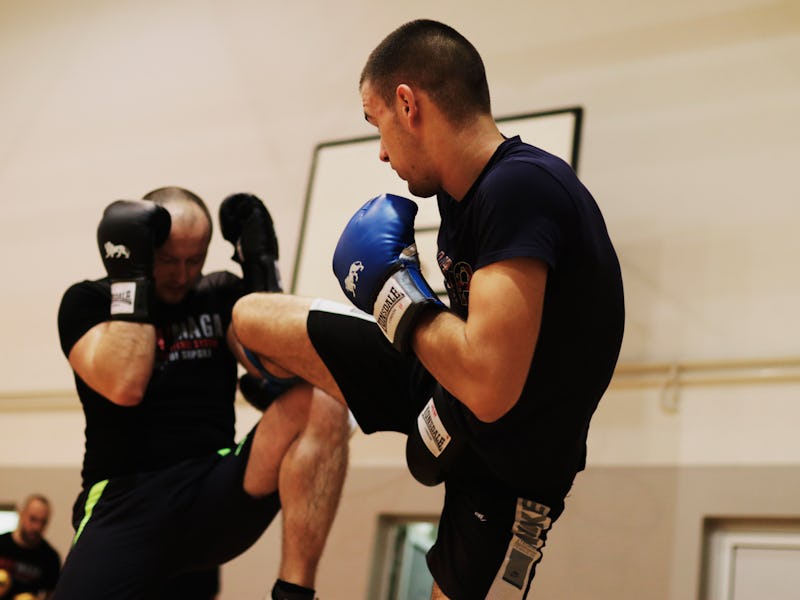Boxing, Despite Its Problematic Flaws, Could Save Men From a Worse Future
The key is to avoid a "one-glove-fits-all" policy.

Boxing is often praised as a way of teaching discipline, anger management, and teamwork. Now, with violent crime on the rise in English cities —especially among young men and boys — the sport is being used to support those at risk of being drawn into knife crime and gang activity. For instance, Channel 4 News recently featured a boxing academy in London, which provides alternative education for young people excluded from school, led by mentors who have experienced similar challenges.
The government’s response to England’s knife crime surge has so far been to increase the use of stop-and-search without reasonable suspicion, introduce knife crime prevention orders, and most recently to announce legislation requiring schools, hospitals, and youth groups to report those young people at risk of being drawn into knife crime.
Academic research shows that punitive approaches such as these can actually alienate young people and make the problem worse. Yet, there is a lack of clear evidence regarding the sport’s capacity to prevent crime and promote community cohesion. Boxing, in particular, divides opinion. For some, it provides an opportunity for young men in particular to escape a life of crime. Others maintain that the sport breeds violence.
To make the most of the positive opportunities that boxing can provide to young people, it’s crucial to understand the context of the sport — and best to proceed with caution when promoting it as a solution to serious youth violence.
Escape to the Gym
The famous sociologist and ethnographer Loïc Wacquant believes that the boxing gym can be a shield against the temptations and dangers of the street. He discusses how the gym can represent “an island of stability and order,” which promises to assist with the complicated and sometimes chaotic lives of those who attend.
Boxing is a complex sport, he says, and boxing gyms define themselves as places that can drive positive change while simultaneously reflecting the “neighborhood and grim realities of the ghetto.”
Fighting for respect.
One only has to look at the range of films — Rocky, Creed, and Southpaw, to name but a few — to see how the gym is venerated as a place for men to build friendships, find meaning and direction, and escape the realities of poverty and street violence. But can it really stop them from being the victims or perpetrators of violent crime?
While the local boxing gym is often viewed as an ideal place to combat social problems such as gangs, it’s important to think about what boxing actually teaches people. Researchers at the Manchester Centre for Youth Studies have been involved in a number of projects researching youth gangs and the impact of boxing on young men.
Respect or Retribution?
The young men in our projects spoke of the value they place on the ideas of respect and masculinity, which for them were strongly associated with boxing. When exploring what support they may need to desist from offending behaviors, they spoke of “being part of something,” “having a routine,” combined with “respect and confidence” and “discipline.”
It’s fair to say that boxing teaches young men discipline, dedication, and respect; nevertheless, it also teaches them how to fight. Not every boxer uses their skills to fight outside of the gym — but more attention needs to be paid to those who do. And it’s crucial that government-funded gang interventions are only put in place when leaders have well-developed knowledge and understanding of the local context.
Our research highlighted that, while boxing is great at diverting young people during periods when they might otherwise get involved in criminal activity, the messages passed down in the gym can sometimes reinforce the view that violence is a practical solution to a problem.
Our data highlighted that hyper-masculine talk — which advocates pride and total respect — arguably contributes to this. Some of the messages being transmitted in boxing gyms exclude women, promote homophobia, and bear similarities to attitudes that can also be heard on the street —attitudes that promote violent retaliation, as a way to gain “respect.” For example, using words such as “gay” or “girl” to emphasize cowardly behavior, as opposed to “warrior” and “gladiator” to emphasize bravery.
Boxing can indeed be a great hook for change: It gives young people a place to hang out and develop themselves, while also diverting those who might otherwise get involved in crime. But to harness its full potential, we need a better of understanding of whether and how it is effective as a sport that can reduce violent crime. Funding should be made available to evaluate local boxing programs and identify good and bad practice, to avoid a “one-glove-fits-all” policy that promotes boxing as a means of addressing knife crime.
This article was originally published on The Conversation by Deborah Jump and Hannah Smithson. Read the original article here.